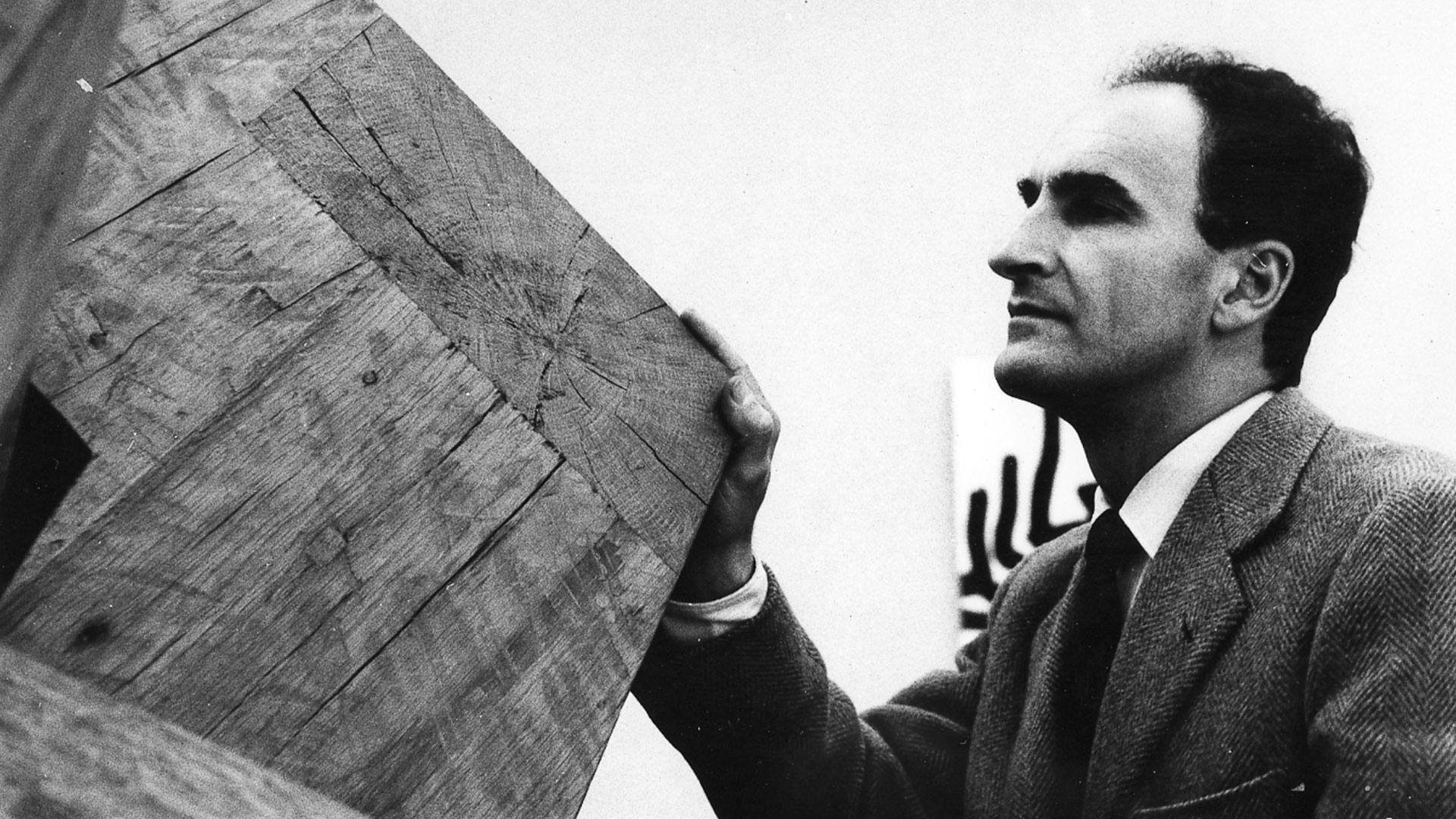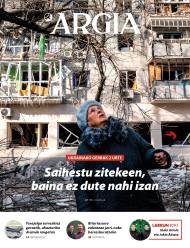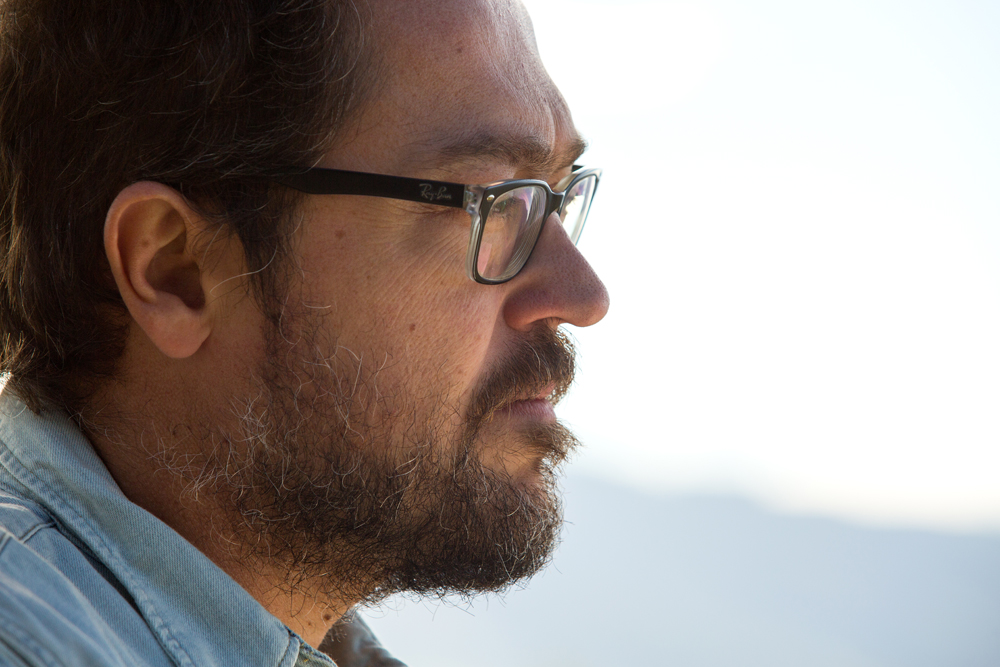About the need to be Chillida
- At the expense of the centenary of the birth of Eduardo Chillida, the media of all ideologies have dominated hagiographies and no mention has been made of his “ultra radical Falangist youth”.

On January 10, 2024, Eduardo Chillida was born 100 years ago. The December 2023 press in Madrid, San Sebastian and Bayona announced that it would be one of the "characters" of 2024. Prophzia is the motorway of the ephemerides and, true to the quotation, the Basque Journal created a special issue of over 80 pages for the Saturday following the anniversary, with a text by the president of the Spanish Government, the lehendakari of the Government and the mayor of San Sebastian, among others. The next day, the home page and the main story of the publication El País Weekly, did so on Gara Zazpika Sunday. But to the surprise of many, two great passages of the life of the Donostian sculptor and three long unknown pieces, as well as in other Basque, Spanish and French newspapers, magazines, radio and television.
In 2023 it is 50 years since the death of Pablo Neruda. In the reports published on behalf of the event, in addition to the literary works and political positions of the writer, almost all journalists highlighted two fundamental issues: rape of a woman and abandonment of her daughter.
In 2023 it is 50 years since the death of Pablo Picasso. As in the case of Neruda, in all the reports of a certain length, they emphasized that the brilliant painter and committed person against Nazism and imperialist wars was also a batterer.
In the Diario Vasco of
January 6, 2024, on behalf of his father, 84 pages of color supplements, Eduardo Chillida had his headline 100 years, in Spanish. Pedro Sánchez, President of the Spanish Government (PSOE), wrote an anecdote that is always mentioned about the beginning of the sculptor: “The young Eduardo abandoned the Architecture studies of Madrid in 1942, because the Real signed for the post of porter, when his father, Pedro Chillida, was appointed president of the txuri-urdin group. Eduardo Chillida's goalkeeper's career ended with a serious injury that forced him to abandon his career as a footballer after five interventions. He returned to the artistic work for the common fortun and discovered in sculpture his natural expression."
No one chooses their parents, so
no one should judge what their parents have done.
However, it is true that
Eduardo Chillida did not take distance from his father's military tasks and, nevertheless, thanks him very much for the support received.
This narrative is always repeated in Chillida's propaganda. Although a president of the PSOE should know the ideology of a president of a football team from the Second Spanish Division of 1942, Pedro Sánchez avoided this nuance. But who was Eduardo Chillida's father? And how did he manage to become president of the Real between 1942 and 1945?
His father, Pedro Chillida Aramburu, was a military man since 1909. The fascist coup d'état of 18 July 1936 was one of the four men he organized in San Sebastian. The Basque Right (DVA) was part of the ultracatolic group, which since the founding of the Second Spanish Republic conspired in favor of the return of the monarchy. Pedro Chillida was then infantry captain and organized paramilitary groups to carry out the coup.
In any case, the anarchists frustrated the San Sebastian coup. The failure was so great that, at noon on July 18, the Chillida group, composed essentially of DVA and Spanish Renewal militants, dispersed and its members returned to their daily lives so that they would not be identified as coup d'état. But on 20 July, the faithful to the Republic arrested Pedro Chillida and took him to Ondarreta prison. He was subsequently transferred on 9 September to the Arantzazu-Mendi boat prison, where he remained until his transfer to Carmen Prison in Bilbao on 14 December. On June 19, 1937, the glorious army […] liberated Bilbao and then Pedro Chillida was left in the hands of the new military authorities of San Sebastian and Burgos. Chillida continued to struggle with the tracks until the end of the war.
.jpg)
Pedro Chillida was still a convinced military columpist while he was president of La Real. This information is still collected and stored in the detailed resume of the Spanish infantry navy Service Sheet, available in the Military Archive of Segovia. He was a red hunter until his final retirement in 1951. He also became a military judge and decided whether the defendants would die in trials where there was no guarantee. It is true that in these times when anything is found on the Internet, this information is not present, but there are books dealing with the topic: Monumental works of Vicente Talón (Memoria de la guerra de Euskadi 1936, Plaza & Janés, 1988), Manuel Chiapuso (Los anarquistas y la guerra en Euskadi, Txertoa, 2009) or books of Germán Ruiz Guerra Llano (Militar y Civil en el País Vasco). Leales, uprisings and geographies, Ediciones Beta, 2019) gather the office of whoever was president of the main Donostiarra football team. Like all the Spanish presidents of the time, he was a passionate figure in favor of Franco.
.jpg)
.jpg)
No one chooses
their parents, so no one should judge what their parents have done. It is not a credit, not the other way around, for our ancestors. It is also true that Eduardo Chillida mentions in his wilful work Conversations, his father (compilation of the sculptor’s daughter, The Factory 2021), which does not take distance from the military tasks of his father and that, however, there is a great gratification for the support he received in his artistic trajectory stica.En all the summaries
about the life of the sculptor are usually quoted three moments: “citizen” The heirs who live from the income of the sculptor’s production do not limit their propaganda only to their sculptures, always cite the ethical question and the commitment. Thus, among other things, it is mentioned that in 1977 he drew the logo of the gesture for amnesty and sent a letter to King Juan Carlos I with the following message:
“The Basque political prisoners who are still in prison, by a large majority of our people, look like men who have fought against the unacceptable oppression of the State (…) I think it would be very important for his Majesty to see the problem of the whole amnesty with the eyes of the Basques.”
.jpg)
Almost twenty years later, in 1996, Chillida wrote to ETA, as the lehendakari Iñigo Urkullu recalled, asking for the freedom of a kidnapped person for almost a year: “Show that you are able to do good action. Liberad Aldaya and help to seek peace for all.” A year later he did the same with the threat of kidnapping and death of Miguel Ángel Blanco: “Your attitude harms this people and any good people. Release Michelangelo and let us all be able to solve the problems with peace and dialogue.”
In any case, there is another anecdote that crosses the life of Eduardo Chillida. Xavier Valls, father painter of former French socialist minister of the interior, Manuel Vallsen, collected it in his memoirs (Pandora's meva capsa, book with writer Julià de Jòdar, Quaderns Crema, 2003), but it is never mentioned with previous events when the sculptor's political trajectory is worked. The anecdote was spread in Basque and Spanish by Mikel Iturri in the blog Harrikadak and, although what counts is serious, cultural journalists have decided to keep it in the shadow (pages 59-61):
"On June 26, 1949, the traditional Cité University End Party Garde was held in [Paris]. Like every year, everyone raised their flag in different pavilions estados.Recuerdo that Sunday morning, some of the members we were on the grass and saw it in the wind, for the first time in the pavilion of Spain, ‘national symbol’. Oriol Palà reasonably caught fire, but we advised him not to speak so high because Eduardo Chillida and Pablo Palazuelo were close to him. They were independent of us and, a little earlier, they said that Franco had not cleaned up all the ‘separatist reds’. In the afternoon parties began in the pavilions and in Spain the director Maravall made a horchata with a bag of chufa expressly brought from Valencia. One day a big bit was heard, followed by the cries of a student named Peres from a room on the first floor. No harm than the high-ranking and powerful doctors Lamote and Perich prevented Chillida from pushing Oriol Palà for the last time out of the window, by then when he had a foot on the feizar he would reach the Spanish flag and remove him from the mast. When Palà returned to the land, Chillida continued to kick her all over her body. More companions approached when the unfortunate ‘two crusaders of Christ the King’ disappeared on the floor of the Maravall and were protected. Closer to death than to life, Jordi Anguera spent the night in bed and I slept on the ground, with the door well closed. Orio Palà grew his face so much that his eyes disappeared. He spent the night in the room, which surely will not remember where, in Sunyer or in August Puigen. The event was very striking at the Cité Universitaire and students from many schools tried not to leave Chillida and Palazuelo. [...] We knew nothing of the two aggressors for a long time, but when one of them had an exhibition of the Galerie Maeght, he went shortly afterwards and when he signed the guestbook, as it usually is in Paris, he put under my name: ‘I still remember the Garden Party of 1949.’ It didn't work for Deusto, but I felt satisfied, like many others, for not having lost my memory."
In the book, later on, Xavier Valls narrates the continuation of history, 30 years later, at the time when Chillida symbolized by amnesty, in 1977:
"In early March we went to Madrid with Pierrette and Theo because it was the tenth anniversary of the Theo Gallery to go to the dinner offered by the Mignon. After dinner, everyone went to the tables and those of Jaime del Asia-Inclán and I, the painter Pepe Caballero and the critic José María Moreno Galván. While we drank a drink with them, Eduardo Chillida and his wife approached. Pepe Caballero wanted to introduce us and Jaime told him he knew who they were for the Vallster. I added that I always remember the events of the Spanish pavilion of the Cité Universitaire de Paris at the Garden Party of 1949. Chillida's wife wanted to leave because we believed she was "drinking," but Chillida said she didn't care if she explained what happened. My wife continued to say that I was ‘drunk’, but Chillida did not move, and Jaime – while away – insisted that he tell all about Moreno Galván and Pepe Caballero. I explained to you with all the nuances the brutal attack and heard Eduardo Chillida, still. Amid the silence that emerged, the sculptor replied that he ‘felt’, but acted under the influence of his domestic environment, since his father was a military. I struck him on the table and told him that at the age of 26 that I then had it was quite cynical to blame the ‘godparents’, and that if all the sons of the military had the same attitude as they did, there would be very few Spaniards. Chillida hasn't stopped hearing, but as her wife pulled her arm out of him, she told me that silent art was once from Estella. I told him that Estella was one of the most backward and fraternal cities I knew, and so he left our table with shame. Jaime looked at us from afar, sat back next to me, and I, after so many years leading the event in my stomach, was calm and happy. Many of the schoolchildren and residents of the Colegio de España knew the attitude of Chillida and Palazuelo, but they all silenced". 186-188.or.
.png)
And in the name of the holy spirit, we should have the opportunity to generate, at the expense of the birth of
Eduardo Chillida, countless investigations and debates, such as cultural policies or the spending on sculpture of the public institutions of Hego Euskal Herria during the last five decades. It is also undeniable that some artists and cultural initiatives benefited from the economic accumulation of some elites thanks to the 1936 coup. The families in which artists would be created, or the families that would be patrons, for example, were enriched. In the Basque case, it is obviously not the only one that should investigate Chillida's.
It is often mentioned that Eduardo Chillida designed a logo against the Basque nuclear coast or in favour of Basque political prisoners. A few months later he regretted making that image that is used to date. Chillida and Pilar Belzunce, real manager of the sculptor's heritage, were always skilled at what was in power, when whoever was in power was anyone. With the Catholic nationalist power of the 1950s, with the Francoist of the 1960s, also in the confusing time of the 1970s, they were born on the left and right, but since 1980 an exciting relationship with the PSOE, real power, and the Spanish reign began. They joined, of course, the PNV and the Basque Government, but also at international level they were close to the social democracy of Western Germany, strategic in Europe. The work of Chillida in Federal Germany, where the economic-political power is large or small, a Chillida, is noteworthy. From Berlin to Bonn, by Münster, Munich and Düsseldorf.
.jpg)
While it is true that the press did not want to pick up some episodes of Chillida's life, in 2006 Nestor Basterretxea, who one more year celebrates the centenary, responded to Irune Berro in a long interview in Berria: “Someday someone writes Another Chillida. He was able to succeed over others, to do anything. He made great efforts to get us out of the center. He was a fascist. His father was one of Mola's men in Gipuzkoa. People didn't know the real Chillida, don't know what it was, or yes, but we don't have historical memory. It is a pity, because without memory we are nothing. The old Fascists without memory are the current democrats.”
Chillida and
Pilar Belzunce, real manager of the sculptor's heritage, were always skilled at what was in power, when whoever was in power was anyone
Six years later, in the same newspaper, he told Pamplona Lasa: “I think it’s an abuse [that of Chillidaleku]. The family is a family business. It's like I charge to get in here and put everything in my pocket. And when things are wrong, the government. Give them. (...) Chillida's father was Mola's trusted man in San Sebastian. This fascist child comes and becomes a nationalist, like a tortilla. And also, for your happiness, the government memelos believe you. It appears in manifestations... I have been told why I am not going to the demonstrations. I don’t need to go to the demonstrations to say I’m Abertzale!”
It is not the only newspaper that has received such statements in recent years. In April 2014, Juan Pedro Quiñonero published in the ABC of Spain a piece about Manuel Valls in which he read:
“Father Valls lived temporarily in the Colegio de España de Paris, in the Ciudad Universitaria. His son Valls heard as many times as we wanted what his father lived in that place, where an ideological ‘simplicity’ prevailed. The history of Eduardo Chillida, his ultra radical Falangist youth, is well known, how he beat a young Catalan, friend of his father, Valls, and future husband of Pierrette Gargallo, daughter and heir of one of the great Spanish sculptors of the twentieth century. When Father Valls settled in the French capital, his friends and interlocutors, including Café Mabillon, were the reflection of this traumatic ‘simplicity’.
The network consultation of this news item draws attention: The ABC newspaper was well published on paper as ‘Chillida’, ‘Chillina’ (sic), perhaps to protect the sculptor’s image.
The question is, why is the beating that Eduardo Chillida gave for political reasons always erased? Why do you hide how Pedro Chillida managed to become president of La Real, and thanks to this was his son the porter Eduardo? What fear do the managers of the artist's heritage generate? Why are the managers of their wealth obsessed with linking Chillida to human rights and dialogue between different, but always forget their “ultra radical Falangist youth”?
Let us continue, as art historians say, the footprint of money: in the glories, in the museums and in the gardens of powerful institutions, from Jerusalem to Gernika. One question for each steel mix.
ETB1eko Dantzatzen den herria saioa Pasai-Donibanetik igaro zen eta asteazken honetan emititu dituzte han grabatutako irudiak. Herriko arku batean dagoen Amnistiaren ikurra estali izanak zenbait pasaitarren arreta deitu du.
Hiru lazo hori agertu dira margotuta Haizearen Orraziko eskulturetako batean. Donostiako Udalak azaldu duenez, "zorionez" erraz garbitu ahal izango dira.
Zortzi urtez itxita egon ostean, apirilean irekiko ditu berriro ateak Hernaniko Chillida Leku museoak.
Idazlea eta arte kritikoa da, baina guztiaren aurretik, behatzailea. Ikusten duen horri irakurketa propio bat gaineratzen dion behatzaile fina. Artelanari ertzak adina erreferentzia ateratzeko gai dena, eta obrari beste begirada bat emango diona. Zuloa saiakera liburuan euskal... [+]















